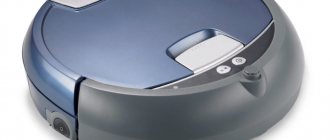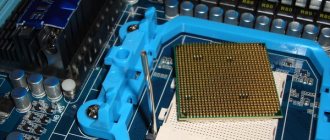Composition, properties and features of choosing thermal paste
Its multicomponent composition includes fillers from microdispersed powders of metals and their oxides, and synthetic and mineral oils are used as a binder.
We list well-proven brands of thermal pastes:
- KPT-8,
- AlSil-3,
- Titan Silver Grease,
- Cooler Master.
The main property of thermal paste for laptops is its high thermal conductivity, much better than that of air. Therefore, when a layer of this material is applied to the junction of the processor and the radiator, normal temperature conditions for the laptop are ensured. Without thermal paste or with old “stiff” substance, the processor will simply burn out.
A signal for the need to change the old thermal paste can be severe overheating of the laptop processor, even under a relatively light load.
You can choose both domestic brands (KPT-8 and AlSil-3) and foreign ones. According to their characteristics, they are identical, but imported ones are slightly more expensive. An additional advantage of domestic pastes is their relative ease of application, since the latter have a more liquid consistency.
If desired, the thermal paste recommended by the processor manufacturer can be found on its website. Usually the results of tests and testing of various pastes are posted there, specific recommendations are given on how to change them and choose the composition. Also try to purchase only high-quality materials for replacement, avoid too cheap ones, as they may turn out to be counterfeit.
Make sure that the composition of the paste is completely homogeneous - the presence of lumps and foreign inclusions in it is unacceptable, since air layers can form that impair thermal conductivity.
How do you know if the thermal paste needs to be replaced?
First, let's find out the maximum temperature of your processor. To do this, enter the name of your processor into the manufacturer's website and find your processor there.
For those who do not know how to determine the name of their processor, download the Speccy . For those who know, it also downloads, because in the future we will need it.
Download, install and launch. A window appears. The program analyzes your system. Let's wait a little. We'll see the following soon.
General information is provided here. We look at the 2nd line or section where it says “Central Processing Unit”. And look at the name, it is opposite the temperature of your processor.
I type IntelCorei5 2450 into the search bar on the manufacturer’s website and look for mine there, you look for yours. In this case, I have Intel. You can have either Intel or AMD. We found our processor. We go to the characteristics or specifications. We are looking for the maximum temperature for the processor.
The temperature you found is the maximum for your processor. Anything more than this figure is bad for the processor. Very! It can burn like that! In addition, in general for all processors 60 degrees is already bad. So keep that in mind.
I have a heating temperature figure in the Speccy program, indicated in red. This is bad. If yours is yellow, good. If it’s orange, it’s bad, but if it’s red, it’s very bad! We fold up the bench and change the thermal paste!
I advise you to load the processor. For example, the same games, only larger in size. For example: Crysis 3. And look at the temperature. If the color is orange, then I don’t recommend playing. Better change the thermal paste. Forget about red, change it urgently! Yellow, you do not need replacement. If it’s yellow or orange, I advise you to change it, for prevention.
Is it worth buying a thermal pad?
First, let's define what a thermal pad is. This is a thin elastic sheet consisting of a base and filler. The base can be rubber or silicone. The latter has the best consumer qualities, but it all depends on the manufacturer and the quality of the materials used. Thermal pads should be stored for no more than a year, so only fresh products should be used. Chinese materials work for about a year and a half, after which they require replacement.
The most important thing is why and whether it is possible to use a thermal pad instead of thermal paste or vice versa. It is recommended to use the materials that the manufacturer himself uses . The thermal pad is indispensable if the distance between the cooling device and the radiator is large (about 1 mm). Otherwise, if you apply a thick layer of thermal paste to the chip instead of a gasket, the device will burn out. Below is a photo of a thermal pad that has dried out and requires replacement.
Rules and procedure for replacing thermal paste
The paste must be changed with the utmost care; it should not be smeared on electronic components and tracks, since it is a conductor due to the inclusion of metal chips. If you do not follow this rule, a short circuit may occur, which will cause the failure of important components of the laptop.
It is better to prepare all the materials and tools necessary for the work in advance. You will need:
- The thermal paste itself;
- Slotted and Phillips screwdriver;
- Unnecessary plastic card;
- A stationery knife and a soft napkin.
When choosing a rag or wipe for removing thermal paste, immediately discard materials with abrasive properties or those that leave pellets when used. Surface scratches and foreign inclusions due to poor removal of old material can significantly impair heat transfer.
What is thermal paste?
Thermal paste, or thermally conductive paste, is a thick substance with high thermal conductivity properties, which is used to transfer heat from one body to another
What is it for?
It is no secret to most people that computers and laptops contain various elements that generate a large amount of heat and require cooling. The more powerful the computer, the more heat it generates. In the production of computer cooling systems, as well as in the production of microcircuits (chips and processors), surface irregularities are allowed, which do not allow the body of the microcircuit (chip or processor) to be tightly pressed to the cooled element and make it difficult to remove heat. In order to smooth out these irregularities, thermal paste is used. It fills the empty space between parts and, due to its thermal conductivity properties, transfers heat from the surface of the processor to the cooling system. This increases the area of contact between the element and the radiator and improves heat transfer from the heating element to the radiator. Thermal paste is used in computers and laptops to increase the efficiency of heat removal from elements such as the central processor, graphics processor (video chip), chipsets and radio elements on the board.
Dried factory paste on a laptop processor
Why change the thermal paste in your laptop?
If one year or more has passed since the application of thermal paste, then by this time the paste begins to dry out until it is completely dry. When dried, its thermal conductivity properties deteriorate, which can lead to the risk of overheating of the elements. Overheating of elements, in turn, can result in unstable operation (shutdowns and freezing due to overheating), the appearance of brakes (reduced processor clock frequency) and failure of microcircuits. Therefore, the thermal paste must be changed in order to extend the service life of the device.
Dried thermal paste
Applying thermal paste to a laptop processor
Replacing thermal paste
If you begin to notice a strong hum from the fans of your computer or laptop, or unstable operation of the device, then it’s time to think about preventive cleaning of the laptop, and at the same time replacing the thermal paste
IMPORTANT: it is worth understanding that the paste is needed only to fill uneven areas and increase the heat transfer area. Too much paste can have a negative effect. The thermal conductivity of the paste is not so high: 1-4 W/(m*K). For comparison: aluminum has 220-240 W/(m*K), and copper has 380-390 W/(m*K).
Applying thermal paste to a laptop processor
Choosing thermal paste
In stores you will most likely come across several types of pastes. Among the popular ones that can be purchased are Kpt8 and Alsil3. There are also pastes from imported manufacturers such as Zalman, Titan and others. They all have approximately similar characteristics that have little effect on the overall result
- Name λ, W/(m*K)
- Copper 380-390
- Aluminum 220-240
- Arctic Silver / Cooling MX 5-8
- Zalman ZM-STG1/2. 1-4
- OCZ Freeze Extreme 4
- Titan Nano Grease TTG 4
- Noctua NT. 2-3
- Gelid GC-Extreme 8
- KPT-8 1
- AlSil-3 2
If you do not have the time and opportunity to make a replacement yourself, you can always contact our FIX62 workshop at Ryazan st. Tatarskaya 91 or Narodny Boulevard 15, where our experienced craftsmen will carry out all the necessary work in a short time, using high-quality materials.
Replacing thermal paste in a laptop. Workshop FIX62 in Ryazan
Sequence of actions when replacing thermal paste
You can change the paste only after disassembling the laptop case. Great care must be taken at this stage to avoid breaking the fragile plastic parts. This is done in the following sequence:
- Remove the battery from the laptop. You may need a screwdriver for this.
- In accordance with the instructions for the device, remove the back panel from it and clean the surfaces from dust.
- Using a napkin, remove any remaining old thermal paste from the surfaces of the processor and heatsink. Old thermal paste for laptops often becomes dull; use alcohol to soften it. But after this, the surfaces to be treated and the motherboard must be thoroughly dried. A regular eraser also works well even with dried paste.
- Apply a layer of new thermal paste to the cleaned surface of the processor. It should be uniform and only a few microns thick. You can’t just level the layer with your finger. There is fat on the skin, the penetration of which into the paste can significantly reduce its thermal conductivity. To apply a thin layer as a kind of “spatula”, it is better to use a plastic thin card or something similar.
Thermal paste must be changed in two stages: Squeeze a small amount of paste out of the tube onto one side of the processor; - Use a credit card to spread a thin, even layer over the surface.
At the final stage of assembly, it is important to correctly mount the cooling radiator. Make sure that when it comes into contact with the processor, the thermal paste does not squeeze out. This is possible if it was applied in too thick a layer. In the future, when carrying out the procedure for cleaning your laptop from dust, do not forget to pay attention to the condition of the thermal paste. If it dries out, the processor will quickly fail.
How often should you change the thermal paste on your video card?
Thermal paste on video cards does not need to be changed as often as on processors. If the video card was purchased new in a store, you shouldn’t think about it at all for the first 2 years. However, from time to time it is worth looking at its temperature.
On average, thermal paste on entry-level graphics adapters up to Nvidia GTX 1050TI or AMD RX 550 is changed every 1.5 - 2 years. And on more powerful ones, such as GTX 1060, 1070, 1080, RX 560 and 580 - once a year.
The first signs of problems with video card cooling are:
- Displaying an image with graphic artifacts.
- Noisy video adapter cooling fan.
- Launching 3D applications ends with an error or system shutdown.
- Poor performance in 3D applications that previously worked reliably.
In order to make sure that the problem is with the video adapter, you should also install the HWiNFO utility. After starting the program, the temperature of the video card can be observed in the Sensors tab. To monitor heating you need:
- Leave the HWiNFO program running.
- Run any heavy game or graphics program in windowed mode.
- Play or work at the computer for 20-30 minutes, paying attention to the temperature sensor.
If the temperature goes beyond 70-75C0, this is a clear sign of insufficient cooling. Replacing the thermal paste will solve this problem, but it is worth remembering that the graphics core crystal is very fragile and often has small components soldered nearby. So cleaning it from the old thermal interface with a fingernail or a brush is a bad idea. It is better to use disposable towels or a soft (dry) cloth.
Old thermal paste on the video card
If after the procedure the temperature has dropped by only a few points, most likely you have a factory-hot video card. These include, for example, ASUS ROG Mars, which was a double GTX 760 and warmed up to 80C0 without any problems.
Or the video card has reference cooling from Nvidia, the design of which has only recently changed. One, always humming turbine on its side, which does little to help the cooling radiator.
NVIDIA GeForce GTX 1080
To learn how to replace thermal paste on a video card, watch the video:











